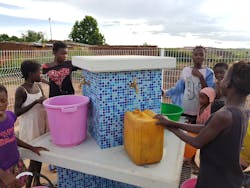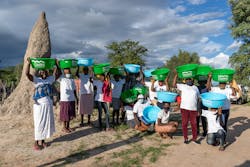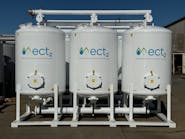Fresh drinking water may be something people often take for granted, but when it comes to a large African country — whose vast area covers extensive regions that differ substantially in their precipitation and water sources — the solutions for a regular supply of drinking water become complex, difficult to implement, and costly.
Drought in Angola
Cunene is located in the southern province of Angola, in Western Africa, bordering Namibia and characterized by extensive and arid territories. A prolonged drought in southern Angola has hit this province, affecting some 80 percent of the local population, including animals, which died in large numbers due to lack of water.
As a result of the severe drought that the region has endured since 2018, it was recognized as a global disaster area and received national and international priority until, during 2019, the President of Angola visited the area to assess and respond to the plight of its residents. The President traveled to a small village called Ombala yo Mungu, where he assured the residents that he would do his best to give the people and the animals living there a source of drinking water.
Following the President’s visit, and on his instruction, the Angolan Ministry of Water approached a number of international companies to provide an urgent response to the water crisis in the area. Owini, a company in the Mitrelli Group international corporation, rose to the challenge, visiting to the village, which is hundreds of kilometers from populated areas. While there, the team from Mitrelli carried out a field survey to understand the drinking water problem and to develop a plan to provide the most appropriate solution for the village.
Following its initial survey, Owini realized that there were two problems. First, there is no potable water in or around the area. In fact, there is only saline groundwater well beneath the surface. Additionally, there is no energy available in the electricity grid to operate water systems, and the area’s rural location meant establishing a supply of fuel for generators would be extremely difficult.
Owini carried out many water tests in the field, including those in old drillings from the Portuguese period, finding brackish water below the surface. At this stage, the whole concept of the project changed from the standard installation of a drinking water supply system to a brackish water desalination system; which posed a complex planning, logistical and economic challenge, in addition to the difficulty of operating and maintaining such a system in a remote, arid region.
Subsequently, Owini decided that a quick solution for desalination was required, with an independent capacity for energy production and storage. The facility would also need to include the ability to store water for several days in the event of a protracted malfunction, until a technician could arrive, due to the distance of the village from more populated areas.
In addition, remote control and monitoring capabilities would need to be installed, in order to enable information about malfunctions to be received — and in many cases also to be handled — without the need to send a technician out to the area.
The Solution
The planned solution is an innovative water desalination system based entirely on solar energy that is able to conserve the energy produced during the day and allow continuous operation around the clock. A water storage facility has also been installed to provide water for three working days minimum, even without pumping water, as professional repairs could require a three-day drive from Luanda, the capital of Angola.
The system involves two drillings to create a continuous throughput, a container with the desalination elements and batteries for energy storage/discharge, and solar panels for all operations. The drinking water is then transported to a ground reservoir, which is sufficient to sustain the population for three days, with an independent pumping station that is also solar-powered.
The reverse osmosis water desalination process, in which salts are separated from water (brackish groundwater in this case) by means of a membrane, produces drinking water, while solar energy production operates the desalination process.
Water is pushed under pressure from the pump to the reservoir, and from there to the drinking facilities around the village. Photovoltaic panels absorb energy from the sun during the day, and deep cycle batteries store some of this energy for use during nighttime operation.
By combining desalination and solar energy , it is possible to supply good quality water for the residents of a very remote settlement where there is no potable water, regular electricity supply, or conventional energy sources.
In addition, it is possible to follow the system’s performance through a remote-control system and monitor its operation from Owini’s office in Israel.
Pandemic Paralysis
The endeavor faced many challenges — floods that destroyed access roads, high-salinity water, lack of energy sources — but the biggest of all was the coronavirus pandemic that paralyzed international activity.
During this period, it was difficult to continue the planning and preparation work in the field, produce the various containers and energy devices in Israel, move the containers full of equipment from Israel to Angola, or move across Angola without first acquiring special permits for travel and work. Despite these challenges, proper planning enabled the project to be executed to the satisfaction of the client.
The project was completed in November 2020 as planned. Drinking water that meets European health standards now flows to the village for the benefit of the local residents and their livestock. Government officials and the local media come to visit, admiring the innovation and creativity of the project.
Following the great success of this project, and as a prototype project for remote areas without a source of fresh water, there is a desire to replicate it in other areas in Angola. Additionally, Owini uses this project to demonstrate solutions for other countries where there are settled areas with extreme climatic characteristics, a lack of available energy and scarce water sources.
This village’s success is part of a much larger project being carried out in Angola called “Water for All.” As the name implies, its purpose is to provide water and long-term, sustainable solutions for global water needs, and to improve the standard of living and health of the local population. WW
About the Author: Shaul Oren is the CTO of the Owini group at Mitrelli.
Published in Waterworld magazine, December 2021.






